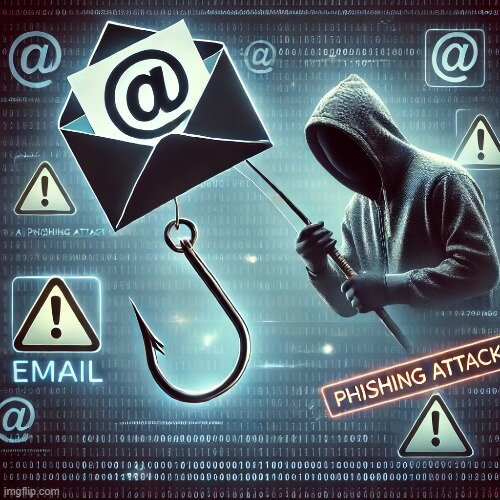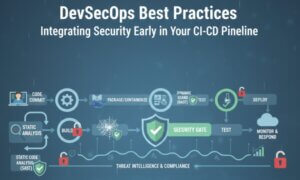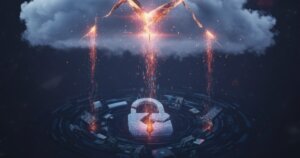Cybercriminals continually seek innovative methods to execute large-scale attacks. One of the most powerful weapons in their arsenal is the botnet—a vast network of compromised devices controlled remotely by hackers. Botnets serve as the fuel for cybercrime, enabling Distributed Denial-of-Service (DDoS) attacks, spam distribution, credential theft, financial fraud, and malware propagation.
Understanding how botnets function, the types that exist, and the cyber threats they power is crucial in combating them. This article delves into the mechanics of botnets, their control mechanisms, different types, and the cyber attacks they facilitate.
Table of Contents

A botnet (short for “robot network”) is a collection of compromised computers, servers, and IoT devices that cybercriminals control remotely. These devices, known as bots or zombies, are infected with malware that connects them to a central command-and-control (C2) server, allowing attackers to orchestrate large-scale cyberattacks.
Botnets operate silently in the background of infected systems, performing malicious activities without the owner’s knowledge. With millions of devices under their command, hackers can launch attacks on an unprecedented scale, creating chaos in the digital world.
How Are Botnets Controlled?
Cybercriminals maintain control over botnets using command-and-control (C2) servers, which act as a hub for issuing commands to infected devices. The two primary architectures used in botnet control are:
1. Centralized Botnets
Operate through a single C2 server that directly communicates with all bots.
Easy to control but vulnerable to detection and takedown.
Example: Early botnets like Zeus used centralized structures.
2. Decentralized (P2P) Botnets
Bots communicate with each other instead of relying on a single server.
Harder to detect and dismantle due to the lack of a single point of failure.
Example: Gameover Zeus, which improved upon the traditional Zeus botnet.
Modern botnets have evolved to use blockchain-based C2 mechanisms, leveraging Tor networks and encrypted communications to evade detection.
Types of Botnets

-spam botnets
Botnets come in various forms, each designed for specific cybercriminal activities:
1. Spam Botnets
Used to send massive volumes of phishing emails and spam messages, often containing malware or links to malicious websites.
Example: Rustock botnet, which at its peak, was responsible for 40% of global spam.
2. DDoS Botnets
Launch Distributed Denial-of-Service (DDoS) attacks by overwhelming websites, servers, or networks with fake traffic, rendering them inaccessible.
Example: Mirai botnet, which infected IoT devices to execute one of the largest DDoS attacks in history.
3. Banking Trojan Botnets
Designed to steal financial data, including login credentials and payment information.
Example: Zeus Botnet, which compromised millions of banking accounts worldwide.
4. Ransomware Botnets
Used to distribute ransomware, encrypting files and demanding ransom payments from victims.
Example: Emotet and TrickBot, which worked in tandem to spread ransomware attacks.
5. Click Fraud Botnets
Generate fraudulent clicks on online ads to manipulate digital advertising revenue.
Example: Methbot, which cost advertisers over $3 million per day.
6. IoT Botnets
Infect smart devices, such as routers, IP cameras, and smart TVs, to expand attack capabilities.
Example: Mozi Botnet, which targets IoT devices to launch DDoS attacks.
Cyber Attacks Powered by Botnets
Botnets serve as a backbone for several major cyber threats. Here’s a look at the most common attacks powered by botnets:
1. Distributed Denial-of-Service (DDoS) Attacks
One of the most devastating cyber threats, DDoS attacks, leverage botnets to overload networks and servers with massive amounts of traffic.
Example: The Mirai botnet attack in 2016, which targeted Dyn, an internet infrastructure company, taking down services like Twitter, Netflix, and Reddit.
2. Phishing and Spam Campaigns
Spam botnets distribute millions of malicious emails daily, infecting users with malware or luring them into scams.
Example: The Cutwail botnet, responsible for sending millions of phishing emails per hour.
3. Credential Theft and Banking Fraud
Financial botnets steal user credentials, credit card details, and banking information through Trojan malware.
Example: The Zeus botnet, which compromised banking accounts worldwide, leading to billions in losses.
4. Ransomware Distribution
Botnets deliver ransomware payloads, locking victims’ data and demanding cryptocurrency payments.
Example: The Emotet botnet, which spread Ryuk ransomware, causing massive financial damage.
5. Cryptocurrency Mining (Cryptojacking)
Botnets secretly mine cryptocurrency using victims’ processing power, leading to high energy consumption and device degradation.
Example: Smominru Botnet, which infected over 500,000 machines to mine Monero cryptocurrency.
6. Political and Nation-State Cyber Warfare
Botnets are increasingly used by nation-state actors to launch cyber espionage and digital warfare.
Example: APT28 (Fancy Bear), a Russian-state-sponsored botnet used for cyber-espionage operations.
The Growing Threat: Future Trends of Botnet Attacks
As technology advances, botnets are evolving with new sophisticated attack techniques:
1. AI-Driven Botnets
Artificial intelligence will enable botnets to self-learn, adapt, and execute attacks autonomously.
2. Ransom DDoS (RDoS) Attacks
Cybercriminals are increasingly using botnets for ransom-driven DDoS attacks, demanding payment to prevent service disruptions.
3. IoT Expansion and 5G Botnets
The rapid growth of IoT and 5G connectivity will lead to more powerful, distributed botnets, increasing attack capabilities.
4. Blockchain-Powered Botnets
Future botnets may use blockchain technology to create decentralized and anonymous control structures, making them harder to track and dismantle.
How to Defend Against Botnet Attacks
1. Keep Devices and Software Updated
Patch vulnerabilities that botnets exploit by regularly updating operating systems, firmware, and applications.
2. Strengthen IoT Security
Change default passwords on IoT devices.
Use firewalls and network segmentation to isolate smart devices.
3. Deploy Advanced Threat Detection Systems
Use Intrusion Detection and Prevention Systems (IDPS) to detect and mitigate botnet-related traffic.
4. Implement Multi-Factor Authentication (MFA)
Adding an extra layer of security prevents unauthorized botnet access.
5. Monitor Network Traffic for Anomalies
Unusual spikes in network activity may indicate botnet activity.
Conclusion
Botnets have transformed large-scale cyber attacks, enabling DDoS disruptions, credential theft, financial fraud, ransomware, and more. With the rise of AI-powered botnets and IoT vulnerabilities, their threat continues to grow.
Understanding how botnets operate and implementing proactive security measures is essential in the fight against these cybercriminal networks. As cyber threats evolve, staying ahead of botnets is the key to securing the digital world.
References
Why Businesses Trust SecureMyOrg For Comprehensive Network Security
At SecureMyOrg, we uncover and fix all possible security vulnerabilities of mobile and web, while providing solutions to mitigate risks. We are trusted by renowned companies like Yahoo, Gojek and Rippling, and with 100% client satisfaction, you’re in safe hands!







Some of the things people reach out to us for –
- Building their cybersecurity program from scratch – setting up cloud security using cost-effective tools, SIEM for alert monitoring, building policies for the company
- Vulnerability Assessment and Penetration Testing ( VAPT ) – We have certified professionals, with certifications like OSCP, CREST – CPSA & CRT, CKA and CKS
- DevSecOps consulting
- Red Teaming activity
- Regular security audits, before product release
- Full time security engineers.
Relevant Posts

What Is Penetration Testing as a Service?
Penetration testing as a service (PTaaS) lets experts simulate real attacks to uncover vulnerabilities before hackers do. This guide explains the process, benefits, and costs, helping businesses strengthen defenses with predictable, ongoing security checks.

How To Inspect Encrypted Traffic Without Breaking Privacy
Network administrators face a challenge: securing systems while respecting privacy. This guide explains how to inspect encrypted traffic without breaking privacy using metadata, anomaly detection, and machine learning ensuring visibility, compliance, and trust.

How to Audit Infrastructure as Code (IaC) for Security Vulnerabilities
Discover how to audit Infrastructure as Code (IaC) for security vulnerabilities with this practical guide. Learn to scan IaC files using tools like Checkov, fix issues like exposed resources, and integrate audits into CI/CD pipelines. Protect your cloud systems from misconfigurations and ensure compliance with clear, actionable steps.

DevSecOps Best Practices: Integrating Security Early in Your CI/CD Pipeline
This article provides a practical guide to embedding security into every stage of your CI/CD pipeline. Learn core DevSecOps best practices like SAST, DAST, dependency scanning, secrets management, and compliance automation to catch vulnerabilities early, foster a culture of shared ownership, and build a secure-by-design development process that accelerates release cycles.

5 Cloud Misconfigurations That Lead to Data Breaches
Cloud misconfigurations are one of the leading causes of data breaches, yet they’re also among the most preventable. From exposed storage buckets to weak IAM policies, attackers exploit these mistakes daily. Learn about the top 5 misconfigurations and how your organization can fix them before they lead to costly data exposure.

How Can Ethical Hacking Training Elevate Your Internal Cybersecurity?
Ethical hacking training empowers organizations to strengthen internal cybersecurity by uncovering vulnerabilities before attackers do. From mastering penetration testing to enhancing incident response, this training builds a proactive security culture. Learn how Secure My ORG’s programs can elevate your team’s skills and fortify defenses against modern threats like AI-driven attacks.
